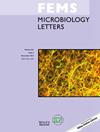引起湖州肠胃炎暴发事件的副溶血性弧菌的致病特征
IF 2.2
4区 生物学
Q3 MICROBIOLOGY
引用次数: 0
摘要
背景 分析了 2022 年湖州市德清县一次肠胃炎暴发事件中分离出的副溶血性弧菌的致病特征。方法 对 30 份肛拭子(26 名患者、1 名厨师和 3 名服务员)进行病原体检测。通过血清分型、脉冲场凝胶电泳(PFGE)分子分型、tdh/trh毒力基因多重荧光PCR检测和药敏试验对分离的副溶血性弧菌进行分析。结果 15 名患者副溶血性弧菌阳性,1 名患者副溶血性弧菌和肠聚集性大肠杆菌(EAEC)阳性,1 名患者肠聚集性大肠杆菌阳性,厨师肠聚集性大肠杆菌阳性。16 个副溶血性弧菌的血清型检测结果为 14 个 O4:KUT 和 2 个 O10:K4。所有样本对其他检测细菌均呈阴性。所有副溶血性弧菌菌株的tdh基因均呈阳性,trh基因呈阴性。16 株分离菌株对氨苄西林(AMP)100% 耐药,对其他 12 种抗生素敏感。从血清型和 PFGE 的结果来看,具有两种血清型的副溶血性弧菌菌株按血清型分为两个分支。三株 EAEC 菌株为非同源菌株。结论 我们从一起爆发的胃肠炎中检测到了副溶血性弧菌和 EAEC。根据溯源结果,具有两种血清型的副溶血性弧菌可能是此次事件的原因。本文章由计算机程序翻译,如有差异,请以英文原文为准。
Pathogenic characteristics of the Vibrio parahaemolyticus which caused a gastroenteritis outbreak event in Huzhou
The pathogenic characteristics of V. parahaemolyticus isolated from a gastroenteritis outbreak event in Deqing County of Huzhou City in 2022 were analyzed. Pathogen detection was performed on 30 anal swabs (26 patients, 1 chef and 3 waiters). The isolates of V. parahaemolyticus were analyzed by serum typing, pulsed field gel electrophoresis (PFGE) molecular typing, multiplex fluorescent PCR detection of tdh/trh virulence gene and drug sensitivity test. 15 patients were positive for V. parahaemolyticus, 1 patient was positive for V. parahaemolyticus and Enteroaggregative E. coli (EAEC), 1 patient was positive for EAEC, and the chef was positive for EAEC. The serotype test results of the 16 V. parahaemolyticus were 14 O4:KUT and 2 O10:K4. All samples were negative for other tested bacteria. All V. parahaemolyticus strains were positive for tdh genes and negative for trh gene. The 16 isolates were 100% resistant to ampicillin (AMP), and sensitive to the other12 antibiotics. From the results of serotype and PFGE, the V. parahaemolyticus strains with two serotypes are clustered into two branches according to their serotypes. The three EAEC strains were non-homologous. We detected V. parahaemolyticus and EAEC from an outbreak of gastroenteritis. And V. parahaemolyticus with two serotypes may be the cause of this event, according to the traceability results.
求助全文
通过发布文献求助,成功后即可免费获取论文全文。
去求助
来源期刊

Fems Microbiology Letters
生物-微生物学
CiteScore
4.30
自引率
0.00%
发文量
112
审稿时长
1.9 months
期刊介绍:
FEMS Microbiology Letters gives priority to concise papers that merit rapid publication by virtue of their originality, general interest and contribution to new developments in microbiology. All aspects of microbiology, including virology, are covered.
2019 Impact Factor: 1.987, Journal Citation Reports (Source Clarivate, 2020)
Ranking: 98/135 (Microbiology)
The journal is divided into eight Sections:
Physiology and Biochemistry (including genetics, molecular biology and ‘omic’ studies)
Food Microbiology (from food production and biotechnology to spoilage and food borne pathogens)
Biotechnology and Synthetic Biology
Pathogens and Pathogenicity (including medical, veterinary, plant and insect pathogens – particularly those relating to food security – with the exception of viruses)
Environmental Microbiology (including ecophysiology, ecogenomics and meta-omic studies)
Virology (viruses infecting any organism, including Bacteria and Archaea)
Taxonomy and Systematics (for publication of novel taxa, taxonomic reclassifications and reviews of a taxonomic nature)
Professional Development (including education, training, CPD, research assessment frameworks, research and publication metrics, best-practice, careers and history of microbiology)
If you are unsure which Section is most appropriate for your manuscript, for example in the case of transdisciplinary studies, we recommend that you contact the Editor-In-Chief by email prior to submission. Our scope includes any type of microorganism - all members of the Bacteria and the Archaea and microbial members of the Eukarya (yeasts, filamentous fungi, microbial algae, protozoa, oomycetes, myxomycetes, etc.) as well as all viruses.
 求助内容:
求助内容: 应助结果提醒方式:
应助结果提醒方式:


